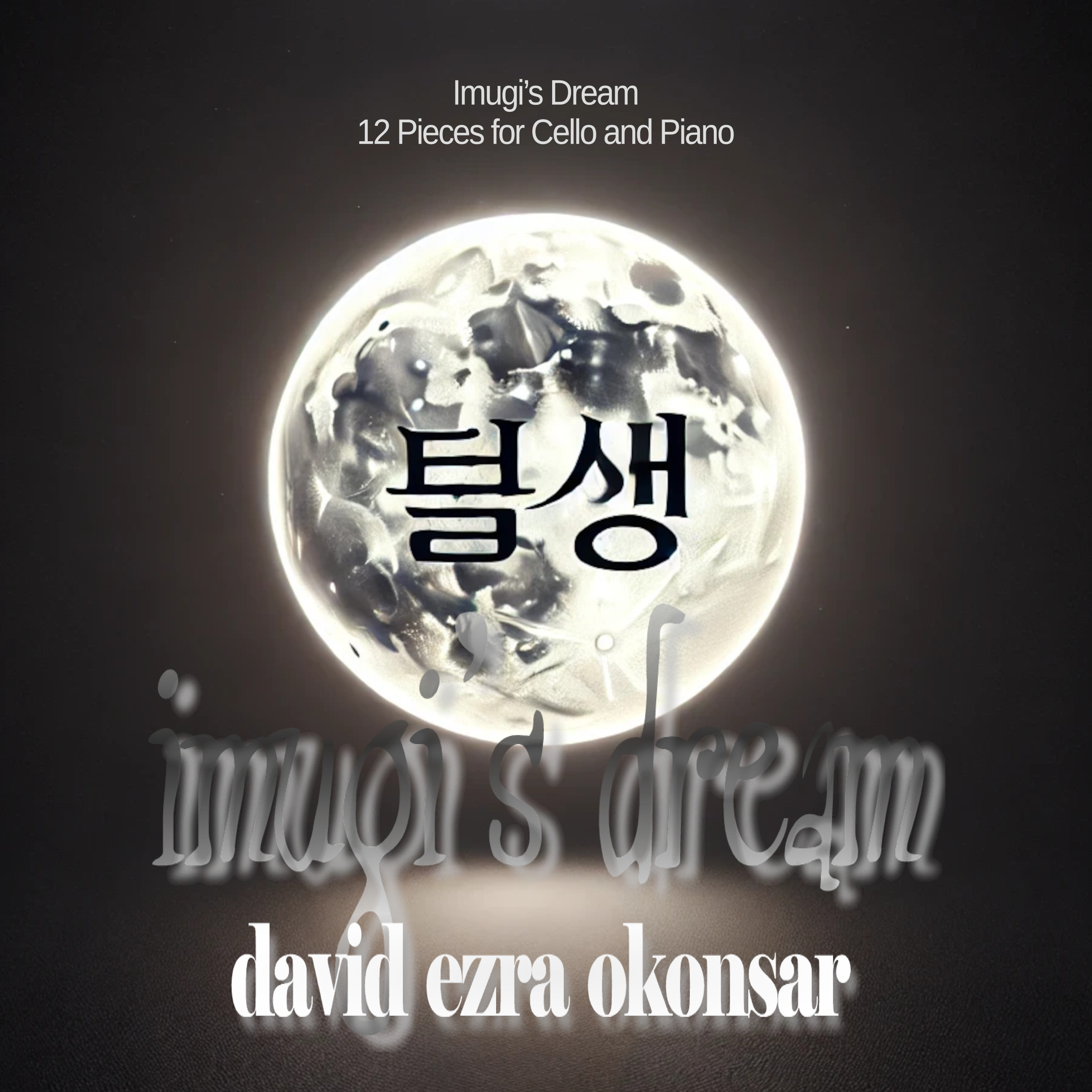
Downloads only. Physical CD not available.
|
Imugi's Dream – A Mythical Journey Through Sound David Ezra Okonşar’s latest composition project, Imugi's Dream: 12 Pieces for Piano and Cello, is a profound exploration of Korean mythology through a contemporary classical lens. Drawing inspiration from the legend of the imugi, a serpent-like creature striving to ascend into the heavens as a dragon, the work weaves together the ancient and the modern, the mythical and the meditative. True to Okonşar’s hallmark style, the music is atonal yet melodious, with lyrical lines and a rich tapestry of unconventional techniques that expand the expressive potential of the piano and cello. At its core, Imugi's Dream invites listeners into an introspective and contemplative state. Each piece within the 12-part cycle reflects a distinct stage in the imugi's mythical journey—from its humble slumber in the shadows of the natural world to its trials, aspirations, and eventual transformation into a celestial dragon. The narrative is not literal but symbolic, offering space for personal interpretation and meditation. The music acts as a mirror, inviting the listener to consider themes of growth, perseverance, and transcendence. The Instrumental Language of Imagination Okonşar’s mastery of instrumentation is evident throughout the work. The piano and cello are treated not merely as vehicles for melody and harmony but as sound sculptures capable of expressing texture, space, and nuance. Imugi's Dream pushes the boundaries of what these instruments can evoke by employing a broad palette of unusual playing techniques. The cello utilizes techniques such as sul ponticello (playing near the bridge), harmonics, and col legno (using the bow's wood), creating ghostly overtones, metallic whispers, and pulsating rhythms. These techniques lend a sense of otherworldliness, as though the imugi itself were voicing its struggle and longing. The piano complements this with prepared techniques—muting strings, plucking them directly, or applying objects to alter the sound—producing bell-like tones, percussive effects, and a resonance that evokes both earth and sky. Together, the instruments create an auditory landscape that is both intimate and vast, mirroring the duality of the imugi's earthbound existence and its celestial aspirations. Atonality with a Lyrical Heart While atonal in structure, the music retains a melodious core, an Okonşar signature. This lyrical quality is not confined to traditional notions of melody but instead emerges from the organic interaction of fragmented motifs, cascading harmonies, and the ebb and flow of dynamics. The pieces are not bound by conventional formal structures but unfold with a sense of inevitability, as if guided by the imugi’s gradual awakening and transformation. This fluidity creates a hypnotic effect, drawing listeners deeper into the narrative with each successive piece. Moments of tension dissolve into stillness, and dissonances give way to fleeting glimpses of resolution, much like the cyclical nature of aspiration and struggle. The listener is left in a meditative state, attuned to the subtle interplay between sound and silence. Meditation Through Mythology Okonşar’s decision to base this work on Korean mythology is both a tribute to cultural storytelling and a reflection of universal themes. The legend of the imugi, though deeply rooted in Korean folklore, resonates with a global audience. It speaks to the human desire for transcendence, the struggle to overcome limitations, and the transformative power of persistence and hope. The music reflects these themes not through overt programmatic gestures but through abstraction. The imugi’s dream is less a direct narrative and more a space for meditation. Listeners are encouraged to bring their own experiences and emotions into the work, making each encounter with the music deeply personal. The Sound of Transformation In Imugi's Dream, the journey from serpent to dragon becomes an allegory for artistic exploration itself. Just as the imugi sheds its limitations to embrace a higher state, the music transcends traditional boundaries, forging a new language for piano and cello. The result is a work that feels timeless and modern, grounded in mythology yet open to infinite interpretations. Okonşar’s composition offers a rare experience: music that challenges the mind, stirs the soul, and invites profound reflection. Imugi's Dream is more than a cycle of pieces; it is a journey—a mythical, musical meditation that lingers long after the final note fades. FR Imugi's Dream – Un voyage mythique à travers le son Le récent projet de composition de David Ezra Okonşar, Imugi's Dream: 12 Pieces for Piano and Cello, est une exploration approfondie de la mythologie coréenne à travers une perspective classique contemporaine. S'inspirant de la légende de l'imugi, une créature semblable à un serpent qui s'efforce de s'élever dans les cieux sous la forme d'un dragon, l'œuvre tisse ensemble l'ancien et le moderne, le mythique et le méditatif. Fidèle au style caractéristique d'Okonşar, la musique est atonale mais mélodieuse, avec des lignes lyriques et une riche tapisserie de techniques non conventionnelles qui élargissent le potentiel expressif du piano et du violoncelle. Au fond, Imugi's Dream invite les auditeurs à un état introspectif et contemplatif. Chaque pièce du cycle en 12 parties reflète une étape distincte du voyage mythique de l'imugi, de son humble sommeil dans l'ombre du monde naturel à ses épreuves, ses aspirations et sa transformation éventuelle en dragon céleste. Le récit n'est pas littéral mais symbolique, offrant un espace d'interprétation et de méditation personnelle. La musique agit comme un miroir, invitant l'auditeur à considérer les thèmes de la croissance, de la persévérance et de la transcendance. Le langage instrumental de l'imagination La maîtrise de l'instrumentation d'Okonşar est évidente tout au long de l'œuvre. Le piano et le violoncelle sont traités non seulement comme des véhicules de mélodie et d'harmonie, mais comme des sculptures sonores capables d'exprimer la texture, l'espace et la nuance. Le rêve d'Imugi repousse les limites de ce que ces instruments peuvent évoquer en utilisant une large palette de techniques de jeu inhabituelles. Le violoncelle utilise des techniques telles que le sul ponticello (jouer près du chevalet), les harmoniques et le col legno (utiliser le bois de l'archet), créant des harmoniques fantomatiques, des murmures métalliques et des rythmes pulsés. Ces techniques confèrent un sentiment d'un autre monde, comme si l'imugi lui-même exprimait sa lutte et son désir. Le piano complète cela avec des techniques préparées - couper les cordes, les pincer directement ou appliquer des objets pour modifier le son - produisant des sons de cloche, des effets de percussion et une résonance qui évoque à la fois la terre et le ciel. Ensemble, les instruments créent un paysage auditif à la fois intime et vaste, reflétant la dualité de l'existence terrestre de l'imugi et ses aspirations célestes. Une atonalité au cœur lyrique Bien que de structure atonale, la musique conserve un noyau mélodieux, une signature Okonşar. Cette qualité lyrique ne se limite pas aux notions traditionnelles de mélodie, mais émerge plutôt de l’interaction organique de motifs fragmentés, d’harmonies en cascade et du flux et reflux de la dynamique. Les pièces ne sont pas liées par des structures formelles conventionnelles, mais se déploient avec un sentiment d’inévitabilité, comme guidées par l’éveil et la transformation progressive de l’imugi. Cette fluidité crée un effet hypnotique, entraînant les auditeurs plus profondément dans le récit à chaque morceau successif. Les moments de tension se dissolvent dans le calme, et les dissonances cèdent la place à des aperçus fugaces de résolution, tout comme la nature cyclique de l’aspiration et de la lutte. L’auditeur est laissé dans un état méditatif, en phase avec l’interaction subtile entre le son et le silence. Méditation à travers la mythologie La décision d’Okonşar de baser cette œuvre sur la mythologie coréenne est à la fois un hommage à la narration culturelle et une réflexion sur des thèmes universels. La légende de l’imugi, bien que profondément enracinée dans le folklore coréen, résonne auprès d’un public mondial. Il parle du désir humain de transcendance, de la lutte pour surmonter les limites et du pouvoir transformateur de la persévérance et de l'espoir. La musique reflète ces thèmes non pas par des gestes programmatiques explicites mais par l'abstraction. Le rêve de l'imugi est moins un récit direct qu'un espace de méditation. Les auditeurs sont encouragés à apporter leurs propres expériences et émotions dans l'œuvre, rendant chaque rencontre avec la musique profondément personnelle. Le son de la transformation Dans Imugi's Dream, le voyage du serpent au dragon devient une allégorie de l'exploration artistique elle-même. Tout comme l'imugi abandonne ses limites pour embrasser un état supérieur, la musique transcende les frontières traditionnelles, forgeant un nouveau langage pour le piano et le violoncelle. Le résultat est une œuvre qui semble intemporelle et moderne, ancrée dans la mythologie mais ouverte à des interprétations infinies. La composition d'Okonşar offre une expérience rare : une musique qui défie l'esprit, remue l'âme et invite à une réflexion profonde. Imugi's Dream est plus qu'un cycle de pièces, c'est une expérience unique. c'est un voyage, une méditation mythique et musicale qui persiste longtemps après que la note finale s'estompe. TR Imugi's Dream – Seslerde Efsanevi Bir Yolculuk David Ezra Okonşar'ın yeni beste projesi, Imugi's Dream: 12 Pieces for Piano and Cello, Kore mitolojisinin çağdaş klasik bir bakış açısıyla derinlemesine bir incelemesidir. Bir ejderha olarak cennete yükselmeye çalışan yılan benzeri bir yaratık olan imugi efsanesinden ilham alan eser, antik ve moderni, efsanevi ve meditatif olanı bir araya getiriyor. Okonşar'ın ayırt edici tarzına sadık kalan müzik, atonal ama melodiktir; lirik dizeler ve piyano ve çellonun ifade potansiyelini genişleten alışılmadık tekniklerden oluşan zengin bir dokuya sahiptir. Özünde, Imugi's Dream dinleyicileri içe dönük ve tefekkürlü bir duruma davet ediyor. 12 parçalı döngüdeki her parça, imugi'nin efsanevi yolculuğunda belirgin bir aşamayı yansıtır: doğal dünyanın gölgelerindeki mütevazı uykusundan, denemelerine, özlemlerine ve sonunda göksel bir ejderhaya dönüşmesine kadar. Anlatı gerçek değil, semboliktir ve kişisel yorumlama ve meditasyon için alan sunar. Müzik, dinleyiciyi büyüme, azim ve aşkınlık temalarını düşünmeye davet eden bir ayna görevi görür. Hayal Gücünün Enstrümantal Dili Okonşar'ın enstrümantasyondaki ustalığı eser boyunca belirgindir. Piyano ve çello yalnızca melodi ve armoni için araçlar olarak değil, doku, alan ve nüans ifade edebilen ses manzaraları olarak ele alınır. Imugi's Dream, alışılmadık çalma tekniklerinden oluşan geniş bir palet kullanarak bu enstrümanların uyandırabileceği şeylerin sınırlarını zorlar. Çello, sul ponticello (köprü yakınında çalma), armonikler ve col legno (yayın odununu kullanma) gibi teknikleri kullanarak hayaletsi üst sesler, metalik fısıltılar ve titreşen ritimler yaratır. Bu teknikler, sanki imugi'nin kendisi mücadelesini ve özlemini dile getiriyormuş gibi, başka bir dünyadan olma hissi uyandırır. Piyano bunu hazırlanmış tekniklerle tamamlar - telleri susturma, onları doğrudan çekme veya sesi değiştirmek için nesneler uygulama - çan benzeri tonlar, vurmalı efektler ve hem dünyayı hem de gökyüzünü çağrıştıran bir rezonans üretir. Enstrümanlar birlikte, hem samimi hem de geniş bir işitsel manzara yaratır ve imugi'nin yeryüzüne bağlı varoluşunun ve göksel özlemlerinin ikiliğini yansıtır. Lirik Bir Kalple Atonalite Yapı olarak atonal olsa da, müzik, melodik özüyle Okonşar imzasını korur. Bu lirik kalite, geleneksel melodi kavramlarıyla sınırlı değildir, bunun yerine parçalanmış motiflerin, kademeli armonilerin ve dinamiklerin gelgitlerinin organik etkileşiminden ortaya çıkar. Parçalar geleneksel biçimsel yapılarla sınırlı değildir, ancak imugi'nin kademeli uyanışı ve dönüşümü tarafından yönlendiriliyormuş gibi kaçınılmazlık duygusuyla ortaya çıkar. Bu akışkanlık, her bir ardışık parçada dinleyicileri anlatının daha da derinlerine çeken hipnotik bir etki yaratır. Gerilim anları durgunluğa dönüşür ve uyumsuzluklar, özlemin ve mücadelenin döngüsel doğasına çok benzeyen geçici çözüm anlarına yol açar. Dinleyici, ses ve sessizlik arasındaki ince etkileşime uyum sağlayan meditatif bir durumda bırakılır. Mitolojiyle Meditasyon Okonşar'ın bu eseri Kore mitolojisine dayandırma kararı hem kültürel hikaye anlatıcılığına bir övgü hem de evrensel temaların bir yansımasıdır. İmugi efsanesi, Kore folklorunda derin köklere sahip olsa da, küresel bir izleyici kitlesiyle yankılanır. İnsanın aşkınlık arzusundan, sınırlamaları aşma mücadelesinden ve ısrar ve umudun dönüştürücü gücünden bahseder. Müzik bu temaları açık programlı jestlerle değil, soyutlama yoluyla yansıtır. Imugi'nin rüyası doğrudan bir anlatıdan çok meditasyon için bir alandır. Dinleyiciler kendi deneyimlerini ve duygularını işe getirmeye teşvik edilir ve müzikle her karşılaşmayı derinlemesine kişisel hale getirir. Dönüşümün Sesi Imugi'nin Rüyası'nda yılanın ejderhaya yolculuğu, sanatsal keşif için bir alegori haline gelir. Tıpkı imugi'nin daha yüksek bir durumu kucaklamak için sınırlamalarından kurtulması gibi, müzik de geleneksel sınırları aşarak piyano ve çello için yeni bir dil oluşturur. Sonuç, mitolojiye dayalı ancak sonsuz yorumlamalara açık, zamansız ve modern hissettiren bir eserdir. Okonşar'ın bestesi nadir bir deneyim sunar: Zihni zorlayan, ruhu harekete geçiren ve derin bir düşünceye davet eden müzik. Imugi'nin Rüyası bir parça döngüsünden daha fazlasıdır; Bu bir yolculuktur; son nota kaybolduktan uzun süre sonra bile devam eden efsanevi, müzikal bir meditasyondur. |
||||||||||||||||||||||||
|
|
||||||||||||||||||||||||
|
||||||||||||||||||||||||





